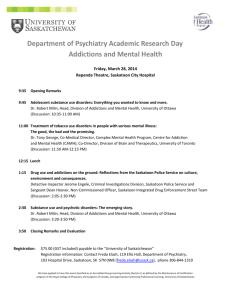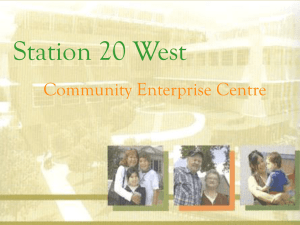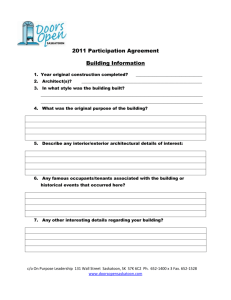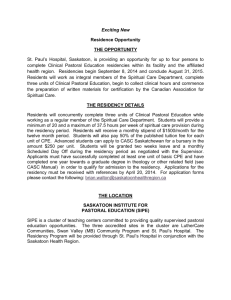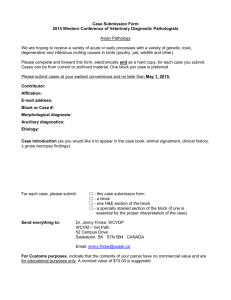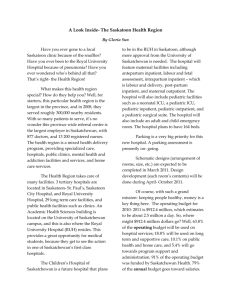special event application form
advertisement
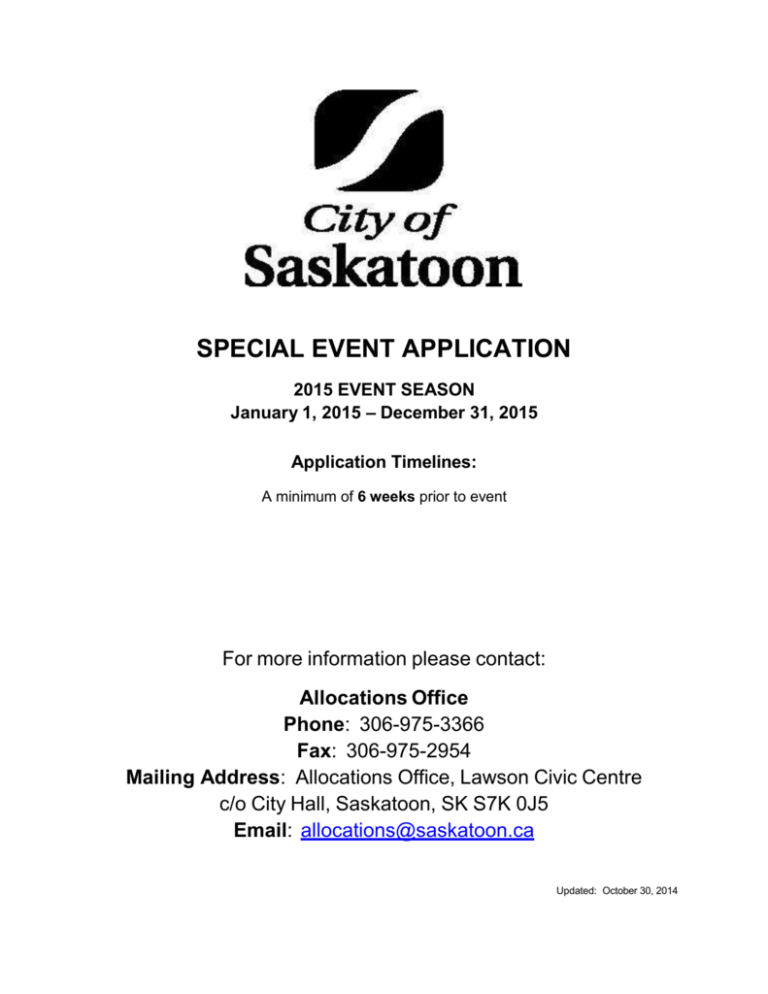
SPECIAL EVENT APPLICATION 2015 EVENT SEASON January 1, 2015 – December 31, 2015 Application Timelines: A minimum of 6 weeks prior to event For more information please contact: Allocations Office Phone: 306-975-3366 Fax: 306-975-2954 Mailing Address: Allocations Office, Lawson Civic Centre c/o City Hall, Saskatoon, SK S7K 0J5 Email: allocations@saskatoon.ca Updated: October 30, 2014 2015 Special Event Application (Continued) 2 TABLE OF CONTENTS – IN THIS DOCUMENT YOU WILL FIND: Special Event Application Checklist ............................................................................................. 3 Important Timelines ..................................................................................................................... 4 Part A – Booking Information ...................................................................................................... 5 Part B – Event Information ......................................................................................................... 5 Part C – Services Required ........................................................................................................ 6 Part D – Site Specifications ........................................................................................................ 6 Part E – Communication Plan..................................................................................................... 7 Part F - Event Organizer’s Additional Responsibilities................................................................. 7 Part G - Additional Information ................................................................................................... 8 Part H – Noise Guidelines for Special Events ............................................................................. 9 Part I – Alcohol Sales and Service.............................................................................................10 Part J – General Vehicle Guidelines ..........................................................................................11 Part K – Signature and Authorization .........................................................................................12 Appendix 1 – Special Event Temporary Facilities, Concessions and Rides Appendix 2 – Event Risk Assessment Appendix 3 – Provision of Civic Services Appendix 4 – Saskatoon Police Service Forms Saskatoon is a warm, welcoming people place 2015 Special Event Application (Continued) 3 SPECIAL EVENT APPLICATION CHECKLIST For the purpose of this application, a special event is defined as: An activity, event, or program located in a City-owned park space, pathway or open space. Has greater impact on the park and neighbouring communities than casual or intended use. Although you may book park space for event use, your event DOES NOT HAVE EXCLUSIVE USE OF THE PARK. You may not fence off a park in a manner that blocks access to the Meewasin Valley Authority (MVA) trails or that prohibits access through the park. Before an application is considered complete, the following information is to be included. Please initial each line acknowledging each item is included in the application: Completed Special Event Application Form Site Map Insurance Certificate indicating $2 million Liability Insurance Have read and understand the “Special Events Temporary Facilities, Concessions, and Rides” document (refer to Appendix 1) City of Saskatoon – Event Risk Assessment form completed (refer to Appendix 2) It is a minimum of 6 weeks prior to your event If your event includes alcohol, the following items are required to be included in your application: Site Map identifying alcohol area A copy of the notice to be sent to residents within a 300 meter radius of the event location Insurance Certificate indicating $5 million Host Liquor Liability Insurance Saskatoon is a warm, welcoming people place 2015 Special Event Application (Continued) 4 IMPORTANT TIMELINES: 5 weeks prior to event, book meeting with park staff for an on-site meeting 4 weeks prior to event, apply to City Council for a noise bylaw extension 2 weeks prior to event, meet with park staff on site 2 weeks prior to event, submit river use permit to Saskatoon Police Service Sergeant 2 weeks prior to event, provide a copy of liquor license to Saskatoon Police Service Sergeant 1 week prior to event, apply for permit to have vehicles in the park Saskatoon is a warm, welcoming people place 2015 Special Event Application (Continued) 5 SPECIAL EVENT APPLICATION FORM January 1, 2015 - December 31, 2015 PART A – BOOKING INFORMATION Name of Organization Address City/Province Postal Code Type of Organization □ Non-Profit Private Company □ Non-Profit Number _______________ □ Community Association Contact Name Daytime Phone Number Fax Number Email Address Alternate Contact Name Daytime Phone Number Fax Number Email Address PART B – EVENT INFORMATION Type of Event: (Check All That Apply) Boot Camp/Fitness Camp Concert/Performance Demonstration/Parade Filming Party/Reception Run/Walk/Marathon Wedding Ceremony Hot Air Balloon Tethering Hot Air Balloon Fireworks Display & Pyrotechnic Special Effects Inflatables (activity bouncer and/or promotional tools) Petting Zoo or Similar Animal Activities Concession (food/refreshments) Detailed Description of the Event: (Include Primary Purpose, Goals, and Objectives) Saskatoon is a warm, welcoming people place 2015 Special Event Application (Continued) 6 Location: Anticipated Total Attendance: Anticipated Peak Attendance: Date Time Event Date (s) and Time(s): Peak Date (s) and Time (s): Set Up Date (s) and Time(s): Take Down Date(s) and Time(s): Provide Details For A Weather Contingency Plan: PART C – SERVICES REQUIRED Access to water * Access to electrical hook-up * Bleachers Community Stage (rental costs apply) Showmobile (rental costs apply) Specify: □ Knock down (4) or □ Portable (2) * Please note not all parks have electrical and/or water availability Event organizers can request to have irrigation lines marked by Parks at (306) 9753303. Event organizers are responsible to contact ALL other underground utilities. PART D – SITE SPECIFICATIONS Describe in detail the event site set-up. Detailed maps must be included at the time of application submission (attach to application). Maps of parks can be requested through the Allocations Office. Items that should be included in the detailed maps are, but not limited to: Tents to be erected (identify number and size) Temporary Stages to be erected (identify number, sizes, and locations) Saskatoon is a warm, welcoming people place 2015 Special Event Application (Continued) Garbage Dumpsters to be brought Portable Toilets to be brought on Generators to be used (identify number) 7 on site (identify number) site (identify number) PART E – COMMUNICATION PLAN Event program information, such as schedule of entertainment, and availability of concessions, etc. is to be shared with any residents or businesses located adjacent to the park. Information must include event dates, times, and road restrictions. Provide a copy of your communiqué and the method that your organization will use to distribute the event information (please check all that apply): Community Association Newsletters Meeting with Community Association Letter to Community Association Posters/Flyers/Pamphlets delivered door to door Other (specify) PART F - EVENT ORGANIZER’S ADDITIONAL RESPONSIBILITIES Event Security: provide a detailed description of how and who will be providing security for the event (e.g. volunteers, a security company, etc). Include specific schedules. Parking Plan: provide a detailed description o f where event staff, volunteers, participants, and spectators will park during the event. Traffic Control: provide a detailed description of traffic control measures, including barricades. For events that will be impacting a roadway, contact Transportation at 306975-2640 to discuss street closures and provision of barricades. Refer to attached “Provision of Civic Services” document for further details (see Appendix 3). Site Visit: Arrange to meet with park staff on-site a minimum of 2 weeks in advance of event date. Contact: East Side Supervisor – 306-975-3396 (Rotary, Diefenbaker, Gabriel Dumont Park) West Side Supervisor – 306-975-3301 (Kiwanis Memorial, Friendship, Victoria Park) Saskatoon is a warm, welcoming people place 2015 Special Event Application (Continued) 8 Emergency Vehicle Access Site Cleanliness: during and immediately following the event, the organizers are responsible for the garbage maintenance and site cleanliness. Noise Bylaw Extension Application has been completed, if applicable. Refer to Part I. Special Occasion Permit has been approved, if alcohol is being served. Refer to Part J. PART G - ADDITIONAL INFORMATION Fire pits are on first-come, first-served basis. Users supply their own firewood for wood fire burning pits. Personal propane barbeques are allowed in parks. Public washrooms are available from 8 a.m. – 10 p.m. from May long weekend to September long weekend. Approval for use of the river for an event is required. Event organizers must contact Navigable Waters Protection Program and Transport Canada (website: www.tc.gc.ca/eng/menu.htm) for the water portion of the event. The proper permits must be submitted to the appropriate Saskatoon Police Service Sergeant, a minimum 2 weeks prior to the event. $2 million liability insurance is a minimum requirement. The City reserves the right to request additional liability insurance. $5 million host liquor liability insurance is a minimum requirement. The City reserves the right to request additional host liquor liability insurance. The City may require a non-refundable damage deposit from an applicant prior to the granting of permission for the use of a park. The amount of the damage deposit shall be at the discretion of the City. Any damage the park incurs is the responsibility of the event organizers to pay for the repair. The total cost of repairs and billing may not occur for up to 12 months after the completion of the event. The City shall approve the use of a park, other than a Neighbourhood Park, according to the following priorities: o First priority will be given to the City’s contractual obligations with respect to the use of the park; o Second priority will be given to one-time events that are Provincial, National, or International in scope; o Third priority will be given to annual, seasonal use bookings – first right of refusal will apply. The City shall approve the use of a Neighbourhood Park according to the following priorities: o First consideration will be given to the events offered by Community Associations in the neighbourhood; and o Second consideration will be given to the events sponsored by youth sport organizations for children under 14 years of age. Saskatoon is a warm, welcoming people place 2015 Special Event Application (Continued) 9 PART H – NOISE GUIDELINES FOR SPECIAL EVENTS Noise Bylaw Hours Are: Monday to Thursday Friday and Saturday Sunday 11 a.m. – 9 p.m. 11 a.m. – 10 p.m. 1 p.m. – 6 p.m. Event organizers are responsible for the monitoring and control of noise resulting from their event. These guidelines are intended to assist organizers in ensuring the noise from the event does not intrude unreasonably on the public living in the area. 1. 2. 3. 4. Event organizers shall designate a responsible individual who is available by phone on a 24 hours basis and who has the authority to respond appropriately to complaints regarding the event. The contact name, phone number, event name, dates, times and location will be provided to any member of the public wishing to contact the event organizers directly. Prior to the event, organizers will contact the Community Association, any business or resident within a 2 block radius with the details of the event and include dates, times, and location of the event. Event organizers should enquire as to whether the association wishes an event representative to attend one of their regular business meetings to discuss any event issues that may affect residents. Contact 306-975-3378 for Community Association contact information. Use of amplification equipment. Noise levels should not exceed 105 decibels measured 100 feet from in front of the stage or location of the speaker system. There needs to be a balanced range of sound to minimize base tones. Speaker systems are to be positioned in a manner that tilts them downward into the crowd attending the event versus projecting over the crowd and into park property. The onus is on the event organizers to self-monitor the sound level. It is recognized that wind and acoustic challenges do not guarantee the decibel readings will not successfully control the noise issue. Program Schedule: the event program shall be scheduled to allow for times when there is no amplified sound. This will assist in alleviating complaints about incessant, repetitive noise. Events that occur outside the Noise Bylaw hours are required to receive permission from City Council for an extension to the bylaw. Noise Bylaw Extension Requests Can Be: Mailed to: The City Clerk’s Office c/o City Hall 222 3rd Avenue North Saskatoon SK S7K 0J5 Emailed to: city.clerks@saskatoon.ca Information To Be Included In The Noise Bylaw Extension Is: Event name, date(s), time Contact and content shared with the Community Association, any business or resident within a 2 block radius with the details of the event. Saskatoon is a warm, welcoming people place 2015 Special Event Application (Continued) 10 PART I – ALCOHOL SALES AND SERVICE Sales or service of alcoholic beverages may be permitted only as a component event. Approval will depend on factors such as park site and type of event. organizer makes to ensure the alcohol sales/service area does not become a focal event are important. History of an event may play a part in the approval sales/service. of a larger Efforts the point of the of alcohol SPECIAL OCCASION PERMIT Sales/Service of alcohol in parks will be subject to the following: Special Occasion permit is applied for and approved. Special Occasion permits can be obtained by contacting the City Clerk’s Office at 306-975-3240 or email city.clerks@saskatoon.ca. This permit is required in order to obtain a liquor permit from the Saskatchewan Liquor and Gaming Authority (SLGA). Apply for and receive a liquor license from SLGA. The liquor license application must include a site map identifying the designated area for liquor and a copy of any additional City Administrative Conditions. Adhere to the SLGA’s terms and conditions (see below for details; additional details may be provided from SLGA based on application). Provide a copy of the liquor license to the appropriate Saskatoon Police Service Sergeant a minimum of 2 weeks prior to the event. A minimum of 2 Special Duty Saskatoon Police Officers hired at the expense of the event organizers. A minimum of $5 million Host Liquor Liability Insurance Notify the Community Association, any business or resident within a 2 block radius with the details of the event. LIQUOR LICENSE SLGA’s Terms and Conditions Security: Trained or licensed security is recommended for large special occasion permit events and may be mandatory for certain specific events. The onus is on the permitted to ensure that adequate security is present at the event. Licensed means a valid security guard license issued by the Law Enforcement Branch of Saskatchewan Justice. Trained means has attended Special Occasion Permit Training as provided by a SLGA Liquor Inspector. The amount and type of security personnel required may be determined by the number of persons attending event and the level of risk the event is perceived to have. Applicants may use the following options as a guide (arranged from least to most risk): Volunteers only (no workshop experience); Trained volunteers only (with workshop experience); Trained volunteers paired with licensed security personnel; or Licensed security personnel only. Saskatoon is a warm, welcoming people place 2015 Special Event Application (Continued) 11 Minimum of 1 trained security personnel for every 100 persons up to 1,000 and 1 trained security personnel for every additional 250 persons. Security personnel are required to have flashlights available as needed and may be required to circulate throughout the permitted areas to patrol for minors and other contraventions of The Alcohol and Gaming Regulation Act, 1997 and its Regulations. Any individual identified as contravening the Act or Regulations shall be addressed immediately. The applicant must ensure that they have the ability to access additional security personnel as required. PART J – GENERAL VEHICLE GUIDELINES These guidelines apply to golf carts, gators, and regular vehicles. All golf carts, gators and vehicles are required to have a permit. Vehicle operators must clearly display their permit. Only service vehicles transporting materials or functioning as part of the program are allowed at any time. Pedestrians have the right of way everywhere. Drivers should make use of hard surfaces within the park and grass should be driven on as little as possible. During set up and take down portions of an event, vehicles are to be used for loading and unloading only, and are not to be parked on site for the duration of set up and take down. During the event, moving vehicles on site are limited to sanitation, emergency vehicles, and shuttle vehicles under the direct supervision of the organizer. Unattended vehicles that are on site and are not identified in the site map or with a permit are subject to ticketing and towing. In wet conditions, all vehicles may be prohibited from driving on the grass. Additional directions provided by City of Saskatoon staff are to be adhered to. Saskatoon is a warm, welcoming people place 2015 Special Event Application (Continued) 12 PART K – SIGNATURE AND AUTHORIZATION I HAVE READ AND WILL COMPLY WITH ALL EVENT REQUIREMENTS Event Contact Signature: Contact Name: (Please Print) Date: OFFICE USE ONLY: Event Authorized and Approved by: Recreation & Sport Division Other Department Required Other Department Required Other Department Required Saskatoon is a warm, welcoming people place APPENDIX 1 • All flammable liquids shall be stored in one central location within your designated pit site. They shall be stored in such a way that they are visible and if persons are residing within the trailer shall not be kept within the trailer. 2. Requirements for Portable Fire Extinguishers • • • • • • • 3. Portable fire extinguishers shall be selected and installed in conformance with NFPA I 0, "Portable Fire Extinguishers" and the National Fire Code of Canada. (NFC 2.1.5.1. and 6.2.1.1.(1).) Portable fire extinguishers shall be inspected, tested and maintained in conformance with NFPA 10, "Portable Fire Extinguishers" Po11able fire extinguishers shall be maintained by a qualified technician at intervals not more than one year. (NFPA 10 4-1.2(3), NFPA 10 4-4.1) Pot1able fire extinguishers shall be conspicuously mounted where they will be readily accessible and immediately available, preferably along normal paths of travel including exits from areas. (NFPA 10 1-6.3) All concessions, temporary structures, tents and other buildings with an electrical service shall have a minimum 2A: 1OB:C portable fire extinguisher on site. All portable hotdog carts, barbeques and other heat producing food equipment shall have a minimum 2A: 1OB:C portable fire extinguisher on site. A portable fire extinguisher with a minimum rating of 5B:C shall be located on the serving cart or table where flaming meals and drinks are being served. Requirements for Class 2 Compressed Gas Cylinders • All Class 2 compressed gas cylinders shall be firmly secured to protect the cylinder from valve damage and falling over. • Cylinders shall not be stored in an exit or access to exit. • Propane cylinders shall not be stored inside any concession, temporary structure or tent, trailer or other building. • Propane cylinders shall be stored in a secured outdoor location or fenced enclosure. 4. Requirements for Emergency Lighting • In larger concessions or temporary structures, emergency lights may be required to provide illumination to the exits in case of power outages. • Emergency lighting units shall be inspected and tested as required by the National Fire Code of Canada. • Emergency light units shall be inspected at intervals not greater than one month to ensure that; pilot lights are functioning and not damaged or obstructed, terminal connections are clean and lubricated, terminal clamps are clean and tight, the battery surface is kept clean and dry, and to ensure the emergency lights will function upon failure of the primary power supply. (NFC 6.5.1.) • Emergency lighting units shall be tested at intervals not greater than 12 months to ensure that the unit will provide emergency power for a duration equal to the design criterion under simulated power failure conditions and to ensure they are functional. (NFC 6.7.1.6. and 6.7.1.7.) Updated August 9, 2011 Page 2 of 6 5. Requirements for Cooking Equipment used in Processes Producing Smoke or Grease-laden Vapors (NFC 6.6.1.1.) • • • • • • • • • • • 6. Concession hood, duct and fire suppression systems must be in conformance with NFPA 96 and meet the UL 300 Standard for Commercial Cooking. All Cooking Appliances must be covered by the Hood and Fire Suppression system and installed to the manufactures specifications. All hoods, ducts and filters must be cleaned on a regular basis so as not to allow a grease build-up. The fire suppression system must be serviced by a qualified technician every 6 months. A tamper seal must be intact and a current dated service tag displayed prominently on the pull station. The system must be interconnect to an electrical contactor and fuel shut off, so if the system is discharged the gas valve will close and the electricity to the appliances will be shut off. Appliance shall have a clearance of 450mm (1 8") from combustible materials. A Class K portable fire extinguisher shall be located in the cooking area with a tamper seal intact and a current dated tab must be prominently displayed on the fire extinguisher. All compressed gas cylinders shall be firmly secured to protect the cylinder from valve damage and from falling over. Cylinders shall not be stored in an exit or access to exit. Emergency contact names and numbers shall be supplied. Staff shall be trained on the operation of the Fire Suppression System, the use of the fire extinguisher and the fire safety plan. Requirements for Open Flames (NFC 2.4.3. and NFC 2.9.3.3.) • • • • • • 7. Open flames whose quantity and method of use create a fire hazard shall not be permitted in processions within assembly occupancies. Flaming meals or drinks shall be ignited only at the location of service. Refueling of equipment used for flaming meals or drinks or for warming food shall be carried out outside the serving area, and away from ignition sources. A portable fire extinguisher with a minimum rating of 5-B:C shall be located on the serving cart or table where flaming meals and drinks are being served. Devices having open flames shall be securely supplied in non-combustible holders and shall be located or protected so as to prevent accidental contact of the flame with combustible materials. Smoking and open flame devices shall not be permitted in a tent or air-supported structure while it is occupied by the public. Requirements for Extension Cords (NFC 2.4.7.1. and CAC) • • • Extension cords shall be used in conformance with the Canadian Electrical Code. Extension cords shall be a minimum of 18 gauge. Extension cords shall be used so as not to create a tripping hazard nor impede any means of egress. Updated August 9, 2011 Page 3 of 6 8. Requirements for Emergency Planning (NFC 2.8.1.1.) • All staff members shall be instructed in emergency planning including: o Locations of exits, fire extinguishers, gas shut off valves, fire extinguishing system manual activation devices o Usage of fire extinguishers, fire extinguishing system manual activation devices, gas shut off valves o Procedures to be followed in case of an emergency o Instructions to be given to the public in case of an emergency o Emergency notifications IE: calling 91 1 • Emergency contact numbers shall be posted 9. Requi rements for Flammable 01·Combnstible Liquids (NFC 2.4.4.) • Empty containers should be used for d isplay purposes. • The amount of flammable/combustible liquids, for an entire "fire compartment" shall not exceed the incidental use, as described in the National Fire Code of Canada. • MSDS information shall accompany all flamma ble/combustible materials displayed. • Propane and other similar products shall not exceed a maximum cylinder size of 5 pounds. The cylinder must be removed from the structure when not attended. 10. Requirements for Seating Arrangements and Exits - Outdoor Assemblies (NFC 2.7., NBC 3.3.2.10., NBC 3.4.2.1. and NBC 3.4.3.4.) • Exit requirements for each tier or balcony: o Capacity of more than 4000 persons - minimum of 4 separate exits o Capacity of more than I 000 persons - minimum of 3 separate exits o All other areas - minimum of 2 separate exits o Exception: For an area with a capacity of not more than 60 persons which has a maximum floor area of l 50m2 and a maximum travel distance of I Sm to an exit, a single exit is permitted. • Exits from outdoor stadia or grandstands shall be located not more than 25m apart. • Travel distance from every seat to the ground, an exit or access to an exit, shall not exceed 45m. • Aisles shall be located so that there are not more than 20 seats between any seat and the aisle, shall be not Jess than 1200mm wide (an aisle serving less than 60 persons is permitted to be 750mm wide) and shall not have steps unless the slope of the aisle is more than I in 8. • Steps provided in an aisle shall extend the full width of the aisle, have risers not more than 230mm high, and have treads with a run not less than 250mm. • The required width of means of egress shall be determined by multiplying the occupant load of the area served by: o l .8mm per person for aisles, stairs other than exit stairs, and ramps and passageways in vomitories and exits, and o 2.4mm per person for exit stairs. Updated August 9, 2011 Page 4 of 6 11. Requirements for Tents and Air-Supported Structures (NFC 2.9. and NBC 3.1.6.) • • • • • • • • • • • • 12. Tents and air-supported structures shall be in conformance with the National Building Code of Canada. Flame retardant treatments shall be renewed as often as required to ensure that the material will pass the match flame test in NFPA 701, "Fire Tests for Flame-Resistant Textiles and Films." Electrical systems in a tent or air-supported structure shall be maintained and operated in a safe manner. Portable electrical systems shall be inspected for fire hazards and defects shall be corrected before the tent or air-supported structure is occupied by the public. The electrical system and equipment in a tent or air-supported structure, including electrical fuses and switches, shall be inaccessi ble to the public. Cables on the ground in areas used by the public in a tent or air-supported structure shall be placed in trenches or protected by covers to prevent damage from traffic. Hay, straw, shavings or similar combustible materials other than necessary for the daily feeding and care of animals shall not be permitted within a tent or air-supported structure used for assembly occupancy, except that sawdust and shavings are permitted to be used if kept damp. Smoking and open flame devices shall not be permitted in a tent or air-supported structure while it is occupied by the public. An air-su pported structure shall be designed as open floor space without interior walls, mezzanines, intermediate floors or similar construction. Tents and air-supported structures shall be a minimum of 3m from other structures and shall be a sufficient d istance from one another to provide a means of emergency egress. Tents of not more than I 20m2 in ground area, located in open spaces may be located less than 3m from one another provided this does not create a hazard to the public. The ground enclosed by a tent or air-supported structure and for not less than 3m outside the structure shall be cleared of all flamma ble material or vegetation that will spread fire. Every tent and air-supported structure and all tarpaulins and decorative materials used in connection with these structures shall conform to CAN/ULC OS I 09-M, "Flame Tests of Flame-Resistant Fabrics and Films." For number of required exits see section on requirements for seating arrangements and exits. Requirements for Vehicles Within a Structure • • • Fuel tanks shall be locked or have a locked fuel cap installed at all times. Recommend batteries are disconnected Propane fuelled vehicles shall have the tank permanently mounted, the fuel system shall be equipped with an automatic stop-fill valve, and the fuel cut-off valve shall be closed. Updated August 9, 20 l l Page 5 of 6 CHECKLIST General Requirements • • • • • • • • • • • • Portable fire extinguisher installed and maintained: Flammable or Combustible liquids properly stored: MSDS information on site: Compressed gas cylinders firmly secured: Propane cylinders stored appropriately outside: Combustible Materials removed from structures or conform to CAN/ULC 08109-M: Emergency lighting i nstalled and tested: Extension Cords meet requirements: Emergency contacts posted: Staff trained in Emergency Procedures: Vehicles have locki ng fuel caps in place: Propane fuelled vehicles maintained as per code: Req uirements for Cooking Equipment • • • • • • • Hood & fire suppression system installed to code: Fire suppression system serviced: Tamper seal & tags in place: Combustible clearance maintained: Class K portable fire extinguisher installed & maintained: Staff trained on use of fire suppression system & potable fire extinguisher: Open flame devices secured: Req ui rements for Seating Arrangements and Exits • Required exits marked and clear of obstructions: • Required aisles maintained and clear of obstructions: Requirements for Tents and Air-su pported Structures • Structure located with required exterior clearances: • Structure constructed of flame-resistant material as per code: • Cables and electrical equipment installed and maintained to code: • Combustible materials removed: • Required exits are maintained: Updated August 9, 201 1 Page 6 of 6 APPENDIX 2 CITY OF SASKATOON - EVENT RISK ASSESSMENT The information gathered in this Risk Assessment form provides the information needed to classify your event into two broad risk categories, either NORMAL risk or ELEVATED risk. Event applications are not denied based on the risk classification. This risk assessment is simply intended to give the event planner a specific set of tools to use in order to comply with the City of Saskatoon Event Planning Bylaw #C11-002 Name of Event: Location of Event: Date(s) of Event: Name of Applicant: Contact #: email: Please refer to the City of Saskatoon Event Application Timeline for a complete description of the event application process. Please answer each of the following questions YES NO 1) 2) Is this an event to support an ongoing charity or a charitable fundraising effort? Will alcohol be served at your event? 3) Will food be served at your event? 4) If your event has been held in previous years: a) Has there been a history of medical emergencies? b) Has there been a history of arrests or criminal activity? c) Has there been a history of traffic congestion related to the event? d) Has parking been a concern? 5) e) Has mass transit been used to move the public to and from the event? Will your event be of a high interest to the media? 6) Will your event feature Display Firework/ Pyrotechnics/Consumer Fireworks? 7) Will your event feature extreme sports? 8) Will your event include a designated spectator/viewing area(s)? 9) 11) Are you planning on using more than 1 form of communications to manage the event (multiple radio channels, cell phones etc)? Will you be working with more than 1 group during the event? (private security, volunteer groups etc) Will your event continue after midnight? 12) Is your venue specifically designed for hosting public events 13) Will your event take place inside? 14) What time of day will your event open to the public? 15) How many total hours will your event remain open to the public before you close/begin to demobilize the site? 16) How many people per day are you anticipating will participate in your venue? 10) Signature of Applicant 8am---12pm---8pm---8am 1hr--8 hrs---16hrs---24 hrs-- 1000--20,000--50,000 Date of Submission: hrs APPENDIX 3 File No. 205-3 No.: Date: (Office Use Only) CITY OF SASKATOON PROVISION OF CIVIC SERVICES NAME OF ORGANIZATION: ORGANIZATION REPRESENTATIVE: MAILING ADDRESS: PHONE NUMBER: Residence Business EMAIL ADDRESS: NAME OF EVENT: DESCRIPTION OF EVENT: DATE(S) TO BE HELD: NUMBER OF PARTICIPANTS (if applicable) WILL CONCESSIONS BE RUN IN CONJUNCTION WITH EVENT? WHAT STREETS (IF ANY) REQUIRE CLOSURE? SERVICES REQUIRED FROM CITY THIS APPLICATION SHOULD BE SUBMITTED BEFORE MARCH 1, 2015, TO: SPECIAL EVENTS INFRASTRUCTURE SERVICES CITY HALL 222 THIRD AVENUE NORTH SASKATOON, SK S7K 0J5 OR BY EMAIL: special.events.transportation@saskatoon.ca
